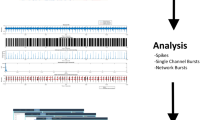Abstract
Planar microelectrode arrays (MEAs) are widely used to record electrical activity from neural networks. However, only a small number of functional recording sites frequently show electrical activity. One contributing factor may be that neurons in vitro receive insufficient synaptic input to develop into fully functional networks. In this study, electrical stimulation was applied to neurons mimicking synaptic input. Various stimulation paradigms were examined. Stimulation amplitude and frequency were tailored to prevent cell death. Two effects of stimulation were observed when 3-week-old cultures were stimulated: (1) clusters of neural cells were observed adjacent to stimulating electrodes and (2) an increase in spontaneous neuronal activity was recorded at stimulating electrodes. Immunocytochemical analysis indicates that stimulation may cause both new neuron process growth as well as astrocyte activation. These data indicate that electrical stimulation can be used as a tool to modify neural networks at specific electrode sites and promote electrical activity.




Similar content being viewed by others
References
Banker GA, Cowan WM (1977) Rat hippocampal neurons in dispersed cell culture. Brain Res 126:397–425
Bentley D, Caudy M (1983) Pioneer axons lose directed growth after selective killing of guidepost cells. Nature 304:62–65
Borkholder DA, Bao J, Maluf NI et al (1997) Microelectrode arrays for stimulation of neural slice preparations. J Neurosci Methods 77:61–66
Brewer GJ, Torricelli JR, Evege EK et al (1993) Optimized survival of hippocampal neurons in B27-supplemented neurobasal, a new serum-free medium combination. J Neurosci Res 35:567–576
Chang JC, Brewer GJ, Wheeler BC (2001) Modulation of neural network activity by patterning. Biosens Bioelectron 16:527–533
Chang JC, Brewer GJ, Bruce CW (2006) Neuronal network structuring induces greater neuronal activity through enhanced astroglial development. J Neural Eng 3:217–226
Chotard C, Salecker I (2004) Neurons and glia: team player in axon guidance. Trends Neurosci 27:655–661
Dowell-Mesfin NM, Abdul-Karim MA, Turner AMP et al (2004) Topographically modified surfaces affect orientation and growth of hippocampal neurons. J Neural Eng 1:78–90
Gross GW (1979) Simultaneous single unit recording in vitro with a photoetched laser deinsulated gold multimicroelectrode surface. IEEE Trans Biomed Eng 26:273–279
Gross GW, Rieske E, Kreutzberg GW et al (1977) A new fixed-array multi-microelectrode system designed for long-term monitoring of extracellular single unit neuronal activity in vitro. Neurosci Lett 6:101–105
Heida T, Vulto P, Rutten WLC et al (2001) Viability of dielectrophoretically trapped neural cortical cells in culture. J Neurosci Methods 110:37–44
James CD, Davis R, Meyer M et al (2000) Aligned microcontact printing of micrometer-scale poly-L-lysine structures for controlled growth of cultured neurons on planar microelectrode arrays. IEEE Trans Biomed Eng 47:17–21
John CC, Gregory JB, Bruce CW (2000) Microelectrode array recordings of patterned hippocampal neurons for four weeks. Biomed Microdevices 2:245–253
Jun SB, Hynd MR, Dowell-Mesfin N et al (2007) Low-density neuronal networks cultured using patterned poly-L-lysine on microelectrode arrays. J Neurosci Methods 160:317–326
Kim IS, Song JK, Zhang YL et al (2006) Biphasic electric current stimulates proliferation and induces VEGF production in osteoblasts. Biochim Biophys Acta 1763:907–916
Ma W, Liu QY, Jung D et al (1998) Central neuronal synapse formation on micropatterned surfaces. Brain Res Dev Brain Res 111:231–243
Martin O, Rubenstein JL (2003) Cell migration in the forebrain. Annu Rev Neurosci 26:441–483
Nam Y, Chang J, Khatami D et al (2004) Patterning to enhance activity of cultured neuronal networks. IEE Proc Nanobiotechnol 151:109–115
Novak JL, Wheeler BC (1988) Multisite hippocampal slice recording and stimulation using a 32-element microelectrode array. J Neurosci Methods 23:149–159
Prasad S, Zhang X, Yang M et al (2004) Separation of individual neurons using dielectrophoretic alternative current fields. J Neurosci Methods 135:79–88
Thomas JCA, Springer PA, Loeb GE et al (1972) A miniature microelectrode array to monitor the bioelectric activity of cultured cells. Exp Cell Res 74:61–66
van den Pol AN, Spencer DD (1999) Differential neurite growth on astrocyte substrates: interspecies facilitation in green fluorescent protein-transfected rat and human neurons. Neuroscience 95:603–616
van Ooyen A, Van Pelt J, Corner MA (1995) Implications of activity dependent neurite outgrowth for neuronal morphology and network development. J Theor Biol 172:63–82
Yoon TH, Hwang EJ, Shin DY et al (2000) A micromachined silicon depth probe for multichannel neural recording. IEEE Trans Biomed Eng 47:1082–1087
Zhuo L, Sun B, Zhang CL et al (1997) Live astrocytes visualized by green fluorescent protein in transgenic mice. Dev Biol 187:36–42
Acknowledgments
This work was supported by the International Collaboration Program, NBS-ERC (Nano Bioelectronics and Systems Engineering Research Center)/KOSEF (Korea Science and Engineering Foundation), NIH, NS-044287 and the Nanobiotechnology Centre (NBTC), an STC program of the National Science Foundation under Agreement Number ECS-9876771. The authors also acknowledge use of the Wadsworth Center Advanced Light Microscopy & Image Analysis Core Facility for the work presented herein.
Author information
Authors and Affiliations
Corresponding author
Rights and permissions
About this article
Cite this article
Jun, S.B., Hynd, M.R., Smith, K.L. et al. Electrical stimulation-induced cell clustering in cultured neural networks. Med Bio Eng Comput 45, 1015–1021 (2007). https://doi.org/10.1007/s11517-007-0218-6
Received:
Accepted:
Published:
Issue Date:
DOI: https://doi.org/10.1007/s11517-007-0218-6




